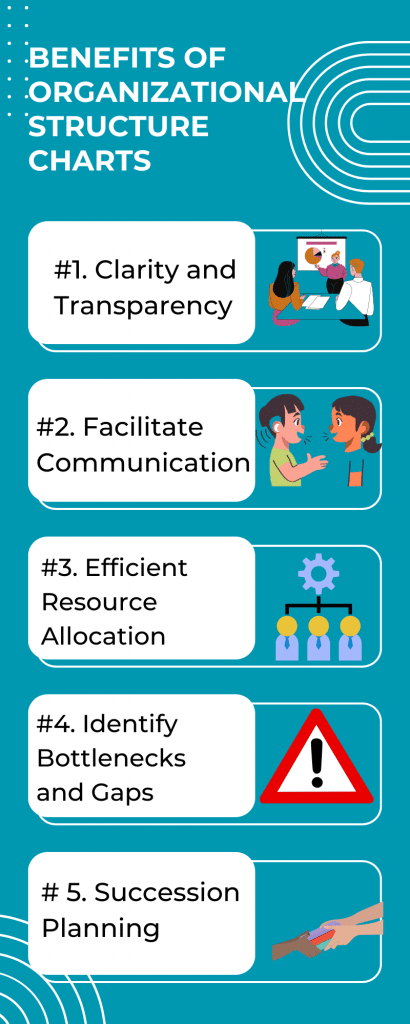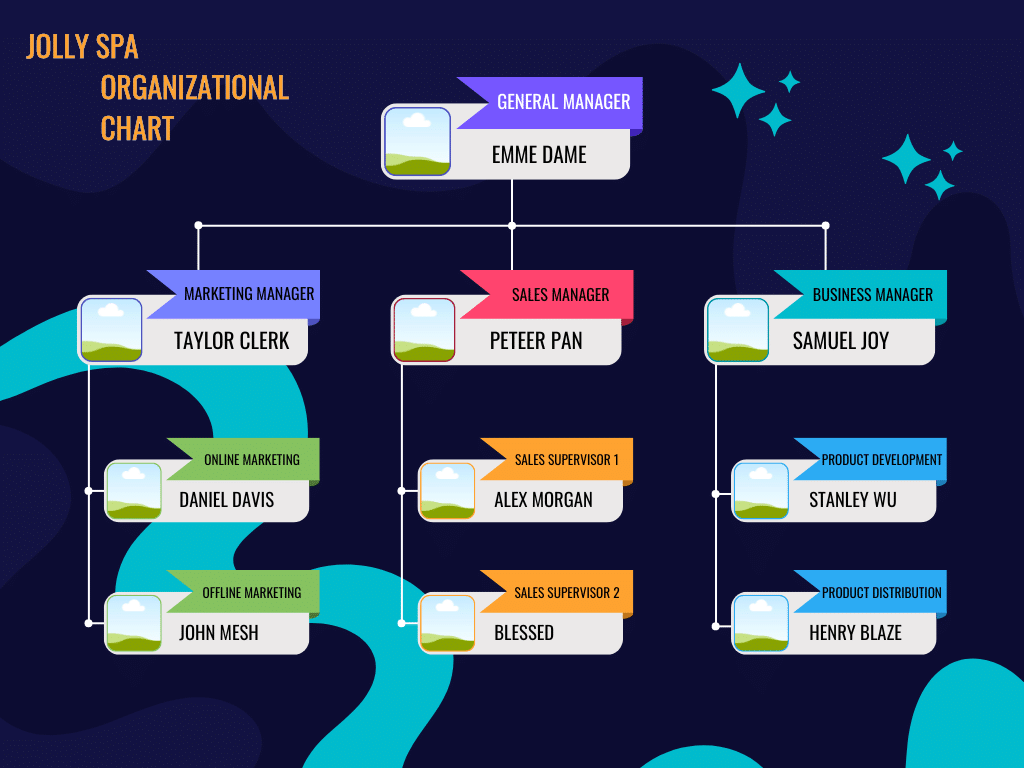Have you ever stopped to think about how the way your company is structured impacts your organization’s growth potential? Well, that’s exactly what we’ll be going into today. As someone who has had a fair amount of experience in the world of business management, I’ve come to realize just how crucial organizational structure is for driving efficiency and, ultimately, promoting business growth.
Key Takeaways
An efficient organizational structure can simplify business operations, empower employees, improve quick decision making process, enhance innovation and productivity in the workplace. This flexibility and agiity will lead to sustainable business growth
Understanding Company Organizational Structure
When it comes to organizational structure, it’s about how your company functions as a whole. Think of it as the framework that holds everything together. Organizational structures determine employee’s roles and objectives, whom they report to, and how all decisions are made.
Organizational structure also refers to how a company arranges its resources, roles, and responsibilities to achieve its business goals. An efficient structure is one that optimally aligns resources, fosters clear communication, and enables quick decision-making
Back when I first started in business, I was part of a small team where everyone performed multiple job roles. I was so disorganized. However, by the time the company experienced growth, I was assigned a single job role. It was at this point that I learned that it is important for an organization to define its roles and responsibilities. As a result, the company became more efficient and innovative, and overall productivity increased as well.
Just like the way the world of business is changing, a company’s organizational structures should also change to become more flexible. For an organization to sustain its long-term efficiency, it must first be flexible enough to adjust and adapt its organizational structure to fit these changes without having to reduce core performance.
Functions of Organizational Structure
An organization can become more efficient and productive when it is structured properly. The following are some ways organizational structure and function can improve the overall efficiency of the company:
#1. Simplify Communication and Coordination
For an organization to be efficient, it must ensure that there is effective communication. This means everyone knows who to turn to for what. Clear communication reduces unnecessary back-and-forth and ensures that projects are smoothly completed.
#2. Adaptable to Change
An efficient organization must ensure that its structure is flexible to adapt to and withstand changes. An efficient organizational structure makes it easy for businesses to quickly adjust when there is a change to business practices to ensure that they remain relevant. This could be technological advancements and other external factors
#3. Define Roles and Responsibilities
When organizations have an efficient structure, the roles and responsibilities of every stakeholder will be clearly defined, which will reduce confusion or duplication of efforts. Each team member can then focus on their specific tasks. This can further improve productivity within the organization
#4. Optimal Resource Allocation
Efficient organizational structures make sure that an organization achieves optimal resource allocation by ensuring that the available resources are used for strategic projects. In essence, organizations can cut unnecessary costs and ensure that resources are channeled toward projects that are most significant to the company’s business objectives
#5. Better Decision-Making Processes
With a clear and efficient organizational structure, the organization can have a quick decision-making process. There’s no need to seek a series of approvals from all the management levels before a decision is made.
I remember a time when there was a series of discussions about expanding into a new market. We were able to quickly decide that after consulting with the key stakeholders, thanks to our well-defined organizational structure.
#6. Employee Empowerment
An effective organizational structure will empower employees with the autonomy to make decisions within their defined roles. This improves employee engagement, leads to enhanced creativity, and contributes to the success of the company’s goals.
The Impact on Business Growth
#1. Simplify Business Operations for Scalability
The business’s operations grow as it expands. But when you have the right organizational structure in place, it becomes very easy to scale up. You can quickly adjust and adapt to these changes and seize new opportunities without much problem.
When the e-commerce giant Amazon, expanded its business operations, it implemented a decentralized organizational structure. With this, it was able to simplify its operations and scale up across various markets and product categories. Conclusively, they were able to maintain their position as a leader in the retail industry while adapting to changing consumer needs
#2. Creating a Framework for Innovation and Adaptability
In today’s changing business world, innovation is key to staying ahead of the curve. A flexible organizational structure encourages creativity and allows businesses to adapt quickly. An example of a company that is innovative and adaptable is Google.
By using the matrix organizational structure, it encourages cross-functional collaboration among the various teams. Consequently, Google has continued to be innovative, from improving search algorithms to self-driving cars.
Furthermore, they have remained at the forefront of technological innovations and continue to maintain their competitive edge in the global market.
#3. Supporting Expansion and Diversification Efforts
Whether you’re expanding into new markets or diversifying your product offerings, an efficient organizational structure will provide your business with the stability it needs to take risks and pursue growth opportunities with confidence.
McDonald’s has become one of the most recognizable and profitable brands worldwide. They are another good example of a brand that a well-crafted organization supports in its expansion and diversification efforts. McDonald’s implemented a hierarchical organizational structure when they expanded into new markets and diversified their menu.
With this structure, they were able to make efficient decisions, and they were also able to successfully adapt their business model to local preferences while maintaining consistent quality standards across their global network of franchises.
Now that you know the impact of an efficient organizational structure chart, the following are some ways you can evaluate your existing structures for efficiency:
Utilizing Organizational Structure Charts
Now, let’s talk about organizational structure charts. These are those awesome diagrams that map out who reports to whom and how information flows within an organization. Organizational structure charts function as an essential tool that enhances efficiency within a company.
Organizational structure charts are visual representations of a company’s hierarchy and reporting workflows. They help employees understand where they fit into the bigger picture and who they can turn to for support or guidance. In essence, organizational structure charts promote efficiency, communication, etc. within an organization. Businesses can effectively use these charts to optimize their operations, maximize productivity, and drive sustainable growth.
Benefits of Using Organizational Structure Charts

#1. Clarity and Transparency
Organizational structure charts show the company’s hierarchy by defining reporting relationships, departmental divisions, and team compositions. This transparency further makes sure that all the employees understand their roles and responsibilities within the organization.
Back when I started working at a marketing agency, I felt a bit lost. Who reports to whom? Who handles what? It was all a bit confusing until I studied the organizational structure chart. Then, I could see the big picture and understand where I fit into the company. It made it easy to navigate the office and my confidence increased because I became sure of my position
#2. Facilitating Communication
By outlining reporting lines and team structures, organizational charts can facilitate communication and collaboration across departments. Employees can easily identify key stakeholders and decision-makers. This will enable them to communicate effectively and seek assistance when needed. This reduces delay and promotes quick information conveyance.
We once played “email tag” when seeking approvals from different departments. It was a headache until we started using the organizational structure chart. Whenever we were unsure of who needed to sign off on what, we consulted it out during meetings. Suddenly, the back-and-forth slowed to a halt, and getting approvals became easier
#3. Efficient Resource Allocation
Organizational structure charts can help top management allocate resources effectively by identifying areas where such resources are needed more, thus maximizing productivity.
My project manager once complained about juggling resources as part of the job. But it wasn’t always easy to know who was available for what. Then, with the organizational structure chart, we were able to see which teams were swamped and which were not. It became easier to allocate tasks and keep projects on track.
#4. Identifying Bottlenecks and Gaps
Using organizational structure charts, businesses can also identify potential bottlenecks and gaps in their workflow. In addition, it can show areas of overlap or inefficiency, and this will help management implement targeted solutions to streamline processes and improve operational efficiency.
Once, during a hectic product launch, we hit a block when it came to getting the final sign-off from the legal team. It seemed like our emails were not getting to the appropriate channel. However, when we consulted the organizational structure chart, we realized there was a missing link in the chain of command. With a quick adjustment, we were back on track in no time.
#5. Onboarding and Training
Organizational structure charts play a crucial role in onboarding new employees and facilitating their integration into the company. When businesses show newcomers a visual roadmap of the organization’s structure, organizations can speed up the onboarding process and ensure that new hires understand their place within the company. Additionally, these charts serve as valuable training tools because they will enable employees to familiarize themselves with the organization’s structure and show them a fast way to navigate internal processes more effectively.
When I joined a marketing company, the organizational structure chart was my best friend. I could see who the “movers” and “shakers” were, who to turn to for help, and where I fit into the grand scheme of things. It made me feel like part of the team from day one.
#6. Succession Planning
By showing the hierarchy of leadership and talent pipelines, businesses can proactively identify and train future leaders. This ensures business continuity and stability during periods of transition or change.
#7. Continuous Improvement
Finally, when businesses regularly review and update their organizational structure charts to reflect changes in staffing, departmental structures, or strategic priorities, they can adjust quickly to changing market conditions, thus enhancing operational efficiency. In my current company, we conduct periodic reviews and updates of our organizational chart to spot inefficiencies and overlaps.
How to Create an Efficient Organizational Structure Chart
As a business, keep it simple and easy to understand whenever you’re creating an organizational structure chart. In addition, be concise, use clear labeling, and try to avoid stuffing the diagram with unnecessary details. You should also update it with time
You will go through several steps when creating an efficient organizational structure chart. Here’s how to do it:
#1. Identify Key Departments and Roles
The first thing you need to do when you’re creating an organizational structure chart is to list out the key departments and roles within the company. This will further help you to simplify the reporting relationships and hierarchy of positions in the organization
#2. Define Reporting Relationships
Next, you should clearly define the reporting relationships between different departments. Clearly define who reports to whom and include direct and indirect relationships within the organization. Moreover, this will help define the key stakeholders in charge of making decisions and communicating within the organization
#3. Define the Functional Areas and Responsibilities
Now, list out the functional responsibilities of each department or team. Furthermore, you should define the scope and primary functions of each role. This will also help the organization ensure that everything is clear and properly aligned.
#4. Choose the Right Format
This is an important aspect when you’re creating your organizational structure chart. You should choose a format that covers your organization’s specific needs, size, and complexity. Some of the common formats to choose from are hierarchical, matrix, flat organizational charts, etc.
#5. Use Clear and Consistent Design Elements
Ensure that the element you are using to design your chart is clear, concise, and consistent throughout. You can also differentiate between the various departments and other functions by color-coding. This will ensure that your chart is easier to understand by everyone within the organization.
#6. Include Key Information
Don’t forget to add the key information to your organizational structure chart. Key information may include things like job titles, names of employees, etc. Each label should clearly show each position or department to avoid confusion. You can also decide to add other basic information, such as contact information, etc. if it’s relevant to your chart.
#7. Seek Feedback
Once you’ve drafted your organizational structure chart, seek input from managers, employees, and other key stakeholders to ensure that the chart accurately reflects the organization’s structure and dynamics.
#8. Update Regularly
The business world is always changing, and as such, your organizational structures must also change over time to reflect these changes. It could be growth, restructuring, or leadership changes. When you update your chart from time to time, it will ensure that the chart remains accurate and relevant to the current state of the organization.
New Trends in Organizational Structure
Traditional hierarchical structures, while they offer a well-defined line of authority, can sometimes stifle innovation and agility. The following are some of the new and emerging trends in 2024:
- Holacracy: This organizational structure emphasizes self-management and, promotes autonomy and innovation among employees. Companies that use the holacracy organization structure will experience better and faster creativity and quick decision-making. Note that this structure is not for every business
- Remote Work: Most organizations are now adopting remote or hybrid work models, thanks to technological advancements. This type of organizational structure promotes utmost flexibility at its peak
- Agile Methodology: At first, this was used only in software development, but now, various industries apply agile principles to their workflow, thus, promoting adaptability, collaboration, and efficiency.
- Network Organizations: Businesses can embrace strategic partnerships and alliances with external stakeholders. This will further enable companies to tap into diverse expertise and resources while remaining agile.
Real-World Examples of Global Brands and How Their Organizational Structure Led to Business Growth
#1. Holacracy: Valve
Valve is a video game development company that uses a unique organizational structure called Holocracy. This type of organizational structure does not use the traditional hierarchy; rather, the employees self-organize themselves into various teams based on the project at hand. This organizational structure promotes individual empowerment and fosters innovation. However, it can be difficult to implement and maintain in most organizations.
#2. Decentralized Structure: Whole Foods Market
Whole Foods is one of the companies that uses a decentralized structure. Here, the company at its various locations is autonomous. This is because the target audience of every store and location has its specific needs, production selection, pricing, and even promotional activities. Their ability to respond to the specific needs of each location has led to their success.
#3. Functional Structure: Ford
Ford uses a functional structure, that groups employees according to the various functions they perform within the organization. By using this structure, the Ford Motor Company promotes expertise and specialization within each department, thereby leading to efficient project execution. An example of a functional chart is

#4. Matrix Organizational Structure: Lego Group
At one point, the Lego group faced declining sales when their organizational structure was rigid. However, they later implemented a “matrix” structure, which increased collaboration between various departments in the company. Their new structure has improved their innovations and has made them develop better products that are successful in the market today
#5. Hierarchical Structure: The United States Military
The United States military is the best example of an organization that uses a hierarchical structure. They have strict protocols and a well-defined line of hierarchical structure for command and control. This has led to clearer and better decision-making during operations.
#6. Matrix Structure: NASA
NASA carries out complex projects, and this requires collaboration across diverse departments. Using this matrix structure has helped NASA develop specialized expertise while ensuring efficient resource allocation for the success of their complex missions. The following is an example of a matrix organizational chart

#7. Hybrid Structure: Spotify
Spotify uses a hybrid structure, that combines elements of hierarchy and functional teams. This hybrid structure allows them to maintain control while fostering teamwork and agility within their development teams. This has led to their success in the world of music streaming.
Best Practices for Optimizing Organizational Structure for Growth
#1. Regular Evaluation and Adjustment
As an organization, you should regularly evaluate and adjust your structure to fit the changing times in the business world and even within the organization. Don’t use an organizational structure, and then just leave it.
#2. Embrace Flexibility and Agility
In 2024, being agile is of utmost importance. Don’t be afraid to try out new organizational models to see what works best for your team and organization.
#3. Prioritize Communication and Transparency
Having a defined line of communication will improve collaboration. It will also make sure that everyone is carried along. An organization should also practice transparency, as it will build trust and empower employees to take responsibility for their work
#4. Data-driven Decision-Making
In this age of data analytics, organizations should use big data to identify areas for improvement. Additionally, they should track metrics like time-to-market, employee engagement, customer satisfaction levels, etc. Furthermore, they can use this information to make strategic decisions when adjusting roles and responsibilities.
Organizations can also use HR analytics to identify skill gaps and training that a company needs to change its organizational structure.
#5. Invest in Skill Development
While changing your structure, it is equally important to invest in employee skill development. Every organization should make sure that their team has the necessary skills to thrive. They can also collaborate with other companies to provide training and development opportunities for their employees, especially if responsibilities shift due to restructuring.
What is an Organizational Structure?
An organizational structure defines relationships within an organization, shows who answers to whom, the hierarchy of key stakeholders, how tasks are divided, etc, and also provides the framework for achieving business goals and objectives
How does the Organization’s Structure Impact its Success?
By defining communication, resource allocation, and decision-making processes, an organization’s structure impacts the success of any organization by ensuring that the organization is efficient, innovative, and adaptable to market changes.
Conclusion
Well, there you have it. When an organization has a flexible and efficient organizational structure, it can empower efficiency within the company. Also, know that your company’s organizational structure is critical in driving efficiency, fostering innovation, and ultimately business growth. So, take the time to check your current structure, make the necessary adjustments, and watch your business grow and achieve its set goals and objectives. Trust me, it’s worth the effort.
- CORPORATE STRUCTURE EXAMPLE: Meaning, Examples & Difference
- BUSINESS ORGANIZATION: Meaning, Types and Examples
- CORPORATE STRUCTURE: Meaning and The Different Types
- Mastering the Marketing Mix: A Personal Journey
- PR Crisis Management in 2024: A Guide for Businesses and Corporations






